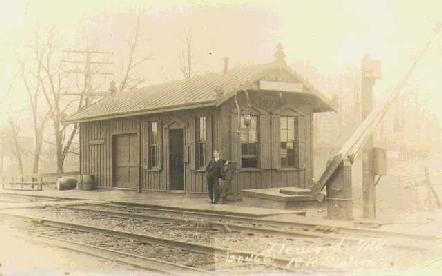
Picture from the collection of Richard A. Cook
The following article was compiled by Jo Seymour from information provided by Carlos P. Avery and the Montgomery County Historic Preservation Commission.
In the late 1800's Derwood, previously just a crossroads with a blacksmith shop and a post office, began its transformation into a small but thriving community. The catalyst was the opening of the Metropolitan Branch of the B & O Railroad, a 43-mile link between Washington, DC, and the B & O "main-stem" at Point of Rocks, MD. The "Met" played an important role in the growth of central Montgomery County and the development of towns and villages along its right-of-way.
Although the Post Office had been operating since 1883, 1886-1889 are significant dates to remember, as it was during this time that the second Derwood station was built (the first was an open "waiting shed"). It was a small Victorian Gothic board and batten structure (see illustration) designed by E. Francis Baldwin, the architect for the B & O Railroad, Baltimore Division. It was constructed at a cost of $682.55. Other stations designed by Baldwin, which are still standing, can be seen in Kensington, Rockville, Gaithersburg, Dickerson, and Point of Rocks.
The Derwood station served not only as a commuter stop but also as a freight and baggage station and an office for handling agricultural and dairy products for the local area. Aside from the railroad and surrounding farming operations, the only other industry was Schwartz's mill (a flour mill) built in 1887 on Chieftain Avenue. The Montgomery County Sentinel of April 15, 1887 noted that the three-story, 32 x 56 structure was to be built directly across the tracks from the railroad station. The B & O built a siding there to serve it.
As the community grew so did the need for housing. The majority of the homes in Historic Derwood today are examples of turn-of-the-century vernacular architecture which housed the workers in the community. Other structures of interest are a church located on the site at 15812 Esquire Court (now used as a Masonic Lodge meetinghouse); a now vacant warehouse and store built in 1903 at the corner of Chieftain and Derwood Rd; and Hall's General Store, now a residence (15833 Derwood Rd). In addition, there is a 1903 Colonial Revival house built by store keeper Clarence Hoskinson which later became the home of the town's miller, Richard Schwartz (15919 Chieftain Avenue). It remains an architectural jewel with its palladian window, pediments, and strong dentilled cornice. These buildings, taken together, represent a grouping of harmonious styles, textures and scale which convey a common history, and are typical of communities which existed in many areas of the county in the later part of the nineteenth century. (Refer to Derwood map.)
A century ago, passenger revenues were sought by the railroads, and by the late 1880's the "high-water mark" in passenger traffic had probably been reached. The May 1887 schedule for the "Met" listed ten inbound trains a day from Derwood to Union Station in Washington, DC. The fare for the hour-long trip was 60 cents with some special group reductions. But sandwiched between the more established communities of Rockville and Gaithersburg, Derwood did not experience the accelerated growth that those cities enjoyed as a result of the railroad. Derwood's population remained small: B & O publications list it as 72 in 1905, 170 in 1917, and 225 in 1928.
Passenger traffic fell steadily in the 1900's as the automobile grew in numbers. As a point of comparison, the 1935 schedule listed only two inbound and two outbound stops each day at Derwood. Then on January 7, 1954, 67 years after its construction, Schwartz Mill caught fire in the early morning hours and was destroyed, as was the Derwood station. The fire put an end to the mainstay of commercial rail traffic there. This, combined with the decline in passenger traffic, made the rebuilding of the station impractical and Derwood station as a stop on the B & O line ceased to exist.
In 1974 the old Derwood post office closed and was reopened in its present location in the Redland Shopping Center. It retained the name "Derwood Branch" thereby designating the 20855 Zip Code area as present day Derwood. The Derwood area was originally referred to as "Deer Park" and it is possible that "Deer Park" later became "Deer Wood" which local idiom translated into "Derwood."
With the construction of the Metro's Red Line to Shady Grove in 1984, the last remaining bits of evidence of the B & O station and the mill in Derwood were erased. But perhaps the Metro's terminus, some 300 yards further north of Redland Road, will be the new "Derwood Station." It has already brought to Derwood the growth and development that the B & O did not.